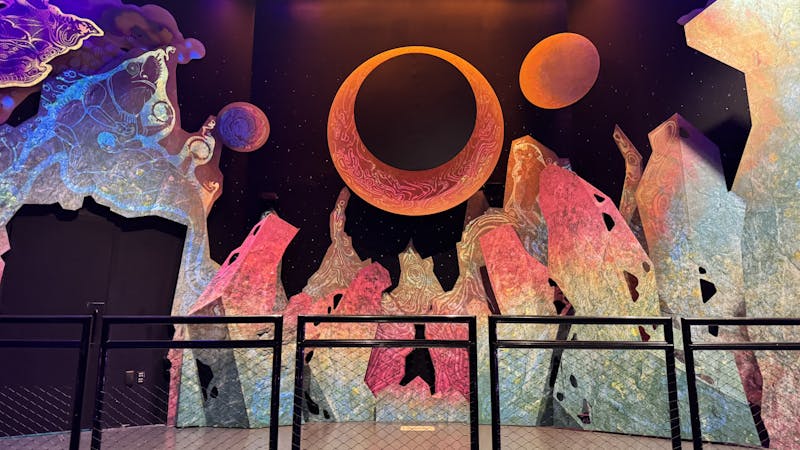Conan Gray’s “Wishbone” is the lucky break fans wanted

For fans of Olivia Rodrigo’s “SOUR,” Gracie Abrams’ “The Secret of Us” and his 2020 debut “Kid Krow,” Conan Gray delivers another masterful heartbreak piece with his fourth studio album “Wishbone.” Collaborating with Dan Nigro, the producer of his first two albums, has brought out more intimate tracks that focus on introspective songwriting. In his Instagram post announcing the album, Gray describes “Wishbone” as an “egregiously niche soundtrack to our own lives” and “the slivers of [himself he’d] always been.” From break-up anthems to yearning ballads, “Wishbone” showcases all the (very relatable) ways a heart can splinter.
“Actor” opens the album as an introduction to the end of the relationship, describing how his ex-partner is much better than the narrator at pretending like nothing ever happened between them. The wistful guitar and vocals paint this angst, building up to a captivating bridge and chorus. This leads into the album’s lead single, “This Song,” a track that details the internal struggle of not knowing whether romantic feelings are mutual. The cinematic strings create a nostalgic atmosphere, particularly felt in the music video depicting the queer summer romance starring Gray and actor Corey Fogelmanis. “Vodka Cranberry,” the next single, furthers the story of their heartbreak with a catchy riff and instrumentation, despite some of the lyrics not measuring up to the depth of other songs.
Alluding to one of the star-crossed lovers in Shakespeare’s famous play, “Romeo” retrospectively questions everything Gray did for his ex — “So I did it all, damn, for what? / You’re no Romeo.” The trumpet introduction and the bridge’s spoken-word cadence contribute to some of the album’s sonic variety. With its twinkly instrumental, “My World” is a playful middle finger to controlling exes, though the shouting quality of the bridge can feel out of place.
Departing from the love theme comes “Class Clown,” a guitar-heavy ballad describing the feeling of not outgrowing past humiliation. It has themes of growing pains and teenage angst felt in Olivia Rodrigo’s “GUTS.” The next track, “Nauseous,” is one of the most vulnerable, with hard-hitting lyrics portraying the trauma-based fear of heartbreak during a relationship — “And maybe that’s why I feel safe with bad guys / Because when they hurt me, I won’t be surprised.”
Gray shifts the tempo with “Caramel,” the final single and a heartbreak anthem akin to “Memories” from his album “Superache.” The percussion and high-pop energy, coupled with the well-delivered metaphor (“You burn inside my memory so well / You caramel”), make it especially memorable. Two more somber songs follow, “Connell” and “Sunset Tower,” which further describe wrestling with the break-up via gut-wrenching lyricism.
“Eleven Eleven” is a key song in the theme of “Wishbone,” brilliantly describing the delusion in desperately searching for signs that a failing relationship can be saved. It accomplishes this through its many references to superstitious items like wishbones, horoscopes, clovers and, of course, the 11:11 make-a-wish trend: “As much as I act like I want to forget it / I still wish for you at 11:11.” Closing out the album is “Care,” Gray’s confession that his ex still matters to him, no matter how much he tries to move on.
Overall, “Wishbone” is a welcome return to Gray’s roots, offering an even more unfiltered look into his love life. As evidenced in interviews about the album and the music videos, Gray seems more confident in his identity as a queer young adult, and each song reflects that vulnerability. While it may not be as out of his comfort zone stylistically, from a lyrical and emotional perspective, “Wishbone” truly shines — no split opinions.
More from The Rice Thresher

Thresher’s guide to arts and entertainment in Houston
New to the city? Unsure how to spend your time procrastinating on homework? You’re in luck — Houston is a playground if you know where to look, and most of it is an easy metro ride or short commute from campus. Here’s a starter pack of spots that deliver fresh air, brain food and the occasional “wait, this is in Houston?” moment.

Thresher’s Lollapalooza report: Who ruled Grant Park?
Chicago’s Grant Park ran on pure dopamine this weekend — surprise debuts, late-but-worth-it arrivals, confetti, fireworks and at least three mass sing-alongs an hour. From Joey Valence & BRAE road-testing new indietronica to A$AP Rocky cracking open his vault, T-Pain turning the field into karaoke and Olivia Rodrigo summoning Weezer, Lollapalooza felt like a live-wire mixtape. Doechii built a universe, TWICE made history and Sabrina signed off with a superstar-cementing finale. Here’s what actually lived up to the skyline.
“Ginny & Georgia” Season 3: A Messy, Magnetic Villain Origin Story
I’ll admit it: I came into “Ginny & Georgia” expecting another glossy Netflix soap that looks great in a weekend binge but evaporates from memory by Monday. By the end of season three, I realized I’d been doing something I rarely do with shows like this: I was taking notes. Not on the plot (though it’s as twisty and outrageous as ever), but on the characters. I loved them. I was grinning from ear to ear watching them scheme, stumble and monologue their way through impossible situations. That’s when I knew: this show had done something right.


Please note All comments are eligible for publication by The Rice Thresher.